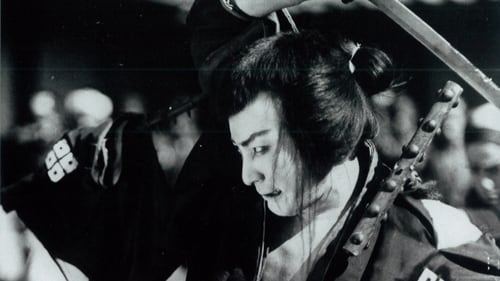Rokuhei Susukita
Рождение : 1899-01-01, Kagoshima Prefecture, Japan
Смерть : 1960-12-18
История
In 1923 he joined Makino Production in Kyoto to write scripts for their major star, Tsumasaburo Bando. Until 1930 he wrote almost 90 scripts for this company and gained an enormous reputation, but that year he decided to write and direct his own films without Bando. He debuted as a director for the Emperor Kine Company (later Shinko Cinema) in 1930 with "The Strange Story of Mito Komon". But none of the 40 films he directed till 1954 were worthwhile. The next year he stopped writing films. Susukita, who during his career used four different pen names, was also creator of the character of Murasaki Zukin, also known as "The Black Hood" or "The Purple Hood" (lit.); which has been converted into film half a dozen of times. The first film Susukita wrote was "Murasaki Zukin: Ukiyo Eshi" ("The Woodcut Artist"), and was directed by Shozo Makino and Bansho Kanamori in 1923. Susukita himself directed one remake in 1931. Chiezo Kataoka played Murasaki in 1958. But the most famous version was made after the death of its author: Ryutaro Otomo played the Black Hood in 1963, directed by Ei'ichi Kudo and adapted by Tai Kato.

Original Story

Original Story
Kataoka Chiezo stars as Murasaki Zukin, a mysterious hero of the people who helps those in need. Now under the rule of the evil Tanuma, the people look to Murasaki Zukin more than ever, to confront and punish those who bring misfortune upon the commoners. Will he be able to bring peace to the land? One of the greatest actors from Toei Studios, known mainly for his swashbuckling roles as powerful swordsmen such as Ryunosuke in SOULS IN THE MOONLIGHT, he appeared in 325 films both before and after the war, beginning with CHUSHINGURA in 1928, and including KUNISADA CHUJI in 1933, and DOKUGANRYO MASAMUNE. While best known for his swordplay, Chiezo really did not enjoy the action, but was able to use his menacing presence to stare down his adversaries. Although Kataoka Chiezo passed away in 1983 at the age of 79, he still has many fans today. This film shows him at his best.

Screenplay

Screenstory
A historical drama directed by Yukiya Sato, and co-written by Rokuhei Susukita and Jiro Okuzawa. Seitarou, who travels from trip to trip, was asked by Fujisuke, who was killed in a mess at the Shinshu Oil Shop's gambling house, to deliver his child Shinkichi to his mother Megumi in the old Iwanjoya in Shiojiri, Shinshu. Megumi was crying day and night, worrying for her child. Masagoro, the boss of the land who had been aiming for the replacement of Iwanjoya, forced Megumi to marry his son Hyokichi. On the way, Seitarou and Shinkichi helped Rohno, who was looking for his fiancee....

Original Story
The purple hood reveals the embezzlement of public money by officials. A remake of Masahiro Makino's 1923 film.

Screenplay
A western occupation propaganda film in which a boy repairs a western style doll that comes to life and uses a magic pen to rebuild his bleak and war torn world into a happy place resembling western civilization.

Screenplay

Screenplay
Хэйдзабуро – ученик знатока «китайской науки» Эйдзан Мацудзуми в замке знатного феодала. Как и все остальные ученики, юноша влюблен в дочь своего учителя Намиэ, однако его необузданный нрав отталкивает от него девушку. Власти также недовольны буйными выходками Хэйдзабуро, и после стычки с самураями, оскорблявшими учителя и Намиэ, Хэйдзабуро изгоняют из замка. Так начинается его полная превратностей скитальческая жизнь. Бескомпромиссность и прямодушие Хэйдзабуро, равно как и цепь несчастливых случайностей, постоянно приводят к конфликтам с самураями. Однажды в трактире он встречает официантку Тиё, которая очень похожа на Намиэ. Угодив в тюрьму в очередной раз, он бежит, чтобы увидеть Тиё, но узнаёт, что она уже вышла замуж. Преследуемый полицией Хэйдзабуро случайно попадает в дом якудзы, который разрешает беглецу остаться у него. Позже хозяин приводит в дом женщину с больным мужем. Увидев, как якудза пристаёт к женщине, Хэйдзабуро узнаёт в ней Намиэ.

Screenplay
Середина эпохи Эдо (1601-1868). В столице Японии, городе Эдо, появляется веселый и проказливый разбойник по прозвищу Кагэбоси. Хотя он и совершает противозаконные действия, в то же время в его поступках есть доля особой иронии и шаловливости. Кагэбоси – отважный защитник слабых и униженных от притеснения властей.

Story
Nanjo Mikisaburo is a young samurai trying to restore his ruined family to its past glory. Enduring the contempt and disdain of high-ranking samurai, Mikisaburo devotes himself to the way of the warrior, mastering the literary and martial arts. His master Kurahashi Jupeita's daughter Misao feels for Mikisahuro who maintains his pride in the face of the arrogant samurai's scorn.

Screenplay
Nanjo Mikisaburo is a young samurai trying to restore his ruined family to its past glory. Enduring the contempt and disdain of high-ranking samurai, Mikisaburo devotes himself to the way of the warrior, mastering the literary and martial arts. His master Kurahashi Jupeita's daughter Misao feels for Mikisahuro who maintains his pride in the face of the arrogant samurai's scorn.

Screenplay
Токутаро - ребенок-сирота, который становится продавцом уличных конфет. Он продает конфеты, напевая песню, которой он давно научился у своей мамы. Однажды по пути он встретился с ворами, и эта встреча изменила их жизнь так, как они не могли себе представить.




